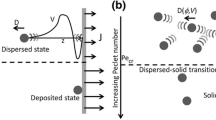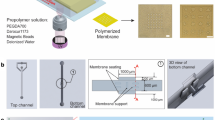Abstract
We report our study on using hydroxyethyl cellulose (HEC) as a dynamic coating for protein separation in microfluidic devices made from cyclic olefin copolymer (COC). The coating significantly enhances hydrophilicity of COC surface, evident from the decrease in contact angle of water in a COC channel. Surface treatment of COC channels with HEC also results in a 72% drop in electroosmotic (EO) mobility and a significant reduction in protein adsorption on the channel wall. Using bovine serum albumin as a model protein, the number of theoretical plates of 1.1 × 104 was achieved in a separation distance of 3.3 cm using free solution electrophoresis. Hydroxyethyl cellulose dynamic coating is also found to have an effect on isoelectric focusing (IEF) of proteins. It not only prevents proteins from adsorption, but also reduces EO flow, both of which help achieve IEF of proteins with a difference of 0.1 pH values in isoelectric points (pI).






Similar content being viewed by others
References
Abad-Villar EM, Tanyanyiwa J, Fernandez-Abedul MT, Costa-Garcia A, Hauser PC (2004) Detection of human immunoglobulin in microchip and conventional capillary electrophoresis with contactless conductivity measurements. Anal Chem 76:1282–1288
Anderson RL (1987) Practical statistics for analytical chemists. Van Nostrand Reinhold, New York
Baker DR (1995) Capillary electrophoresis. John Wiley, New York
Bhattacharyya A, Klapperich CM (2006) Thermoplastic microfluidic device for on-chip purification of nucleic acids for disposable diagnostics. Anal Chem 78:788–792
Boone TD, Fan ZH, Hooper HH, Ricco AJ, Tan H, Williams SJ (2002) Plastic advances microfluidic devices. Anal Chem 74:78A–86A
Buch JS, Kimball C, Rosenberger F, Highsmith WE, DeVoe DL, Lee CS (2004) DNA mutation detection in a polymer microfluidic network using temperature gradient gel electrophoresis. Anal Chem 76:874–881
Castano-Alvarez M, Fernandez-Abedul MT, Costa-Garcia A (2005) Poly(methylmethacrylate) and Topas capillary electrophoresis microchip performance with electrochemical detection. Electrophoresis 26:3160–3168
Castano-Alvarez M, Fernandez-Abedul MT, Costa-Garcia A (2006) Amperometric detector designs for capillary electrophoresis microchips. J Chromatogr A 1109:291–299
Chen XX, Wu HK, Mao CD, Whitesides GM (2002) A prototype two-dimensional capillary electrophoresis system fabricated in poly(dimethylsiloxane). Anal Chem 74:1772–1778
Cui H, Horiuchi K, Dutta P, Ivory CF (2005) Isoelectric focusing in a poly(dimethylsiloxane) microfluidic chip. Anal Chem 77:1303–1309
Das C, Fan ZH (2006) Effects of separation length and voltage on isoelectric focusing in a plastic microfluidic device. Electrophoresis 27:3619–3626
Das C, Xia Z, Stoyanov A, Fan ZH (2005) A laser-induced fluorescence imaging system for isoelectric focusing. Instrum Sci Technol 33:379–389
Das C, Fredrickson CK, Xia Z, Fan ZH (2007) Device fabrication and integration with photodefinable microvalves for protein separation. Sens Actuators A Phys 134:271–277
Dittrich PS, Tachikawa K, Manz A (2006) Micro total analysis systems. Latest advancements and trends. Anal Chem 78:3887–3908
Esch MB, Kapur S, Irizarry G, Genova V (2003) Influence of master fabrication techniques on the characteristics of embossed microfluidic channels. Lab Chip 3:121–127
Fiorini GS, Jeffries GD, Lim DS, Kuyper CL, Chiu DT (2003) Fabrication of thermoset polyester microfluidic devices and embossing masters using rapid prototyped polydimethylsiloxane molds. Lab Chip 3:158–163
Fredrickson CK, Xia Z, Das C, R.Ferguson, Tavares FT, Fan ZH (2006) Effects of fabrication process parameters on the properties of cyclic olefin copolymer microfluidic devices. J Microelectromech Syst 15:1060–1068
Gates BD, Xu Q, Stewart M, Ryan D, Willson CG, Whitesides GM (2005) New approaches to nanofabrication: molding, printing, and other techniques. Chem Rev 105:1171–1196
Griebel A, Rund S, Schonfeld F, Dorner W, Konrad R, Hardt S (2004) Integrated polymer chip for two-dimensional capillary gel electrophoresis. Lab Chip 4:18–23
Herr AE, Molho JI, Drouvalakis KA, Mikkelsen JC, Utz PJ, Santiago JG, Kenny TW (2003) On-chip coupling of isoelectric focusing and free solution electrophoresis for multidimensional separations. Anal Chem 75:1180–1187
Hofmann O, Che DP, Cruickshank KA, Muller UR (1999) Adaptation of capillary isoelectric focusing to microchannels on a glass chip. Anal Chem 71:678–686
Huang XH, Gordon MJ, Zare RN (1988) Current-monitoring method for measuring the electroosmotic flow-rate in capillary zone electrophoresis. Anal Chem 60:1837–1838
Huang B, Wu H, Kim S, Zare RN (2005) Coating of poly(dimethylsiloxane) with n-dodecyl-beta-D-maltoside to minimize nonspecific protein adsorption. Lab Chip 5:1005–1007
Kim DS, Lee SH, Ahn CH, Lee JY, Kwon TH (2006) Disposable integrated microfluidic biochip for blood typing by plastic microinjection moulding. Lab Chip 6:794–802
Klank H, Kutter JP, Geschke O (2002) CO(2)-laser micromachining and back-end processing for rapid production of PMMA-based microfluidic systems. Lab Chip 2:242–246
Koh CG, Tan W, Zhao MQ, Ricco AJ, Fan ZH (2003) Integrating polymerase chain reaction, valving, and electrophoresis in a plastic device for bacterial detection. Anal Chem 75:4591–4598
Lee DS, Yang H, Chung KH, Pyo HB (2005) Wafer-scale fabrication of polymer-based microdevices via injection molding and photolithographic micropatterning protocols. Anal Chem 77:5414–5420
Li Y, Buch JS, Rosenberger F, DeVoe DL, Lee CS (2004) Integration of isoelectric focusing with parallel sodium dodecyl sulfate gel electrophoresis for multidimensional protein separations in a plastic microfludic network. Anal Chem 76:742–748
Li C, Yang Y, Craighead HG, Lee KH (2005) Isoelectric focusing in cyclic olefin copolymer microfluidic channels coated by polyacrylamide using a UV photografting method. Electrophoresis 26:1800–1806
Liu J, Lee ML (2006) Permanent surface modification of polymeric capillary electrophoresis microchips for protein and peptide analysis. Electrophoresis 27:3533–3546
Liu YJ, Ganser D, Schneider A, Liu R, Grodzinski P, Kroutchinina N (2001) Microfabricated polycarbonate CE devices for DNA analysis. Anal Chem 73:4196–4201
Liu J, Pan T, Woolley AT, Lee ML (2004) Surface-modified poly(methyl methacrylate) capillary electrophoresis microchips for protein and peptide analysis. Anal Chem 76:6948–6955
Macounova K, Cabrera CR, Holl MR, Yager P (2000) Generation of natural pH gradients in microfluidic channels for use in isoelectric focusing. Anal Chem 72:3745–3751
Mair DA, Geiger E, Pisano AP, Frechet JM, Svec F (2006) Injection molded microfluidic chips featuring integrated interconnects. Lab Chip 6:1346–1354
Mazzeo JR, Krull IS (1991) Capillary isoelectric-focusing of proteins in uncoated fused-silica capillaries using polymeric additives. Anal Chem 63:2852–2857
Mela P, van den Berg A, Fintschenko Y, Cummings EB, Simmons BA, Kirby BJ (2005) The zeta potential of cyclo-olefin polymer microchannels and its effects on insulative (electrodeless) dielectrophoresis particle trapping devices. Electrophoresis 26:1792–1799
Monahan J, Gewirth AA, Nuzzo RG (2001) A method for filling complex polymeric microfluidic devices and arrays. Anal Chem 73:3193–3197
Muck A, Wang J, Jacobs M, Chen G, Chatrathi MP, Jurka V, Vyborny Z, Spillman SD, Sridharan G, Schoning MJ (2004) Fabrication of poly(methyl methacrylate) microfluidic chips by atmospheric molding. Anal Chem 76:2290–2297
Pugmire DL, Waddell EA, Haasch R, Tarlov MJ, Locascio LE (2002) Surface characterization of laser-ablated polymers used for microfluidics. Anal Chem 74:871–878
Raisi F, Belgrader P, Borkholder DA, Herr AE, Kintz GJ, Pourhamadi F, Taylor MT, Northrup MA (2001) Microchip isoelectric focusing using a miniature scanning detection system. Electrophoresis 22:2291–2295
Richards DP, Stathakis C, Polakowski R, Ahmadzadeh H, Dovichi NJ (1999) Labeling effects on the isoelectric point of green fluorescent protein. J Chromatogr A 853:21–25
Righetti PG, Nembri F (1997) Capillary electrophoresis of peptides in isoelectric buffers. J Chromatogr A 772:203–211
Roberts MA, Rossier JS, Bercier P, Girault H (1997) UV laser machined polymer substrates for the development of microdiagnostic systems. Anal Chem 69:2035–2042
Rohr T, Ogletree DF, Svec F, Frechet JMJ (2003) Surface functionalization of thermoplastic polymers for the fabrication of microfluidic devices by photoinitiated grafting. Adv Funct Mater 13:264–270
Sanders JC, Breadmore MC, Kwok YC, Horsman KM, Landers JP (2003) Hydroxypropyl cellulose as an adsorptive coating sieving matrix for DNA separations: artificial neural network optimization for microchip analysis. Anal Chem 75:986–994
Shadpour H, Musyimi H, Chen J, Soper SA (2006) Physiochemical properties of various polymer substrates and their effects on microchip electrophoresis performance. J Chromatogr A 1111:238–251
Shimura K (2002) Recent advances in capillary isoelectric focusing: 1997–2001. Electrophoresis 23:3847–3857
Shin JY, Park JY, Liu CY, He JS, Kim SC (2005) Chemical structure and physical properties of cyclic olefin copolymers (IUPAC technical report). Pure Appl Chem 77:801–814
Shoffner MA, Cheng J, Hvichia GE, Kricka LJ, Wilding P (1996) Chip PCR. I. Surface passivation of microfabricated silicon–glass chips for PCR. Nucleic Acids Res 24:375–379
Soper SA, Ford SM, Qi S, McCarley RL, Kelly K, Murphy MC (2000) Polymeric microelectromechanical systems. Anal Chem 72:642A–651A
Stachowiak TB, Rohr T, Hilder EF, Peterson DS, Yi M, Svec F, Frechet JM (2003) Fabrication of porous polymer monoliths covalently attached to the walls of channels in plastic microdevices. Electrophoresis 24:3689–3693
Stoyanov AV, Das C, Fredrickson CK, Fan ZH (2005) Conductivity properties of carrier ampholyte pH gradients in isoelectric focusing. Electrophoresis 26:473–479
Tan W, Fan ZH, Qiu CX, Ricco AJ, Gibbons I (2002) Miniaturized capillary isoelectric focusing in plastic microfluidic devices. Electrophoresis 23:3638–3645
Tian HJ, Landers JP (2002) Hydroxyethylcellulose as an effective polymer network for DNA analysis in uncoated glass microchips: optimization and application to mutation detection via heteroduplex analysis. Anal Biochem 309:212–223
Verzola B, Gelfi C, Righetti PG (2000) Quantitative studies on the adsorption of proteins to the bare silica wall in capillary electrophoresis. II. Effects of adsorbed, neutral polymers on quenching the interaction. J Chromatogr A 874:293–303
Vogt O, Pfister M, Marggraf U, Neyer A, Hergenroder R, Jacob P (2005) A new two-chip concept for continuous measurements on PMMA-microchips. Lab Chip 5:205–211
Wang YC, Choi MH, Han J (2004) Two-dimensional protein separation with advanced sample and buffer isolation using microfluidic valves. Anal Chem 76:4426–4431
Woolley AT, Mathies RA (1994) Ultra-high-speed dna fragment separations using microfabricated capillary array electrophoresis chips. Proc Natl Acad Sci USA 91:11348–11352
Xiao DQ, Van Le T, Wirth MJ (2004) Surface modification of the channels of poly(dimethylsiloxane) microfluidic chips with polyacrylamide for fast electrophoretic separations of proteins. Anal Chem 76:2055–2061
Xu Y, Zhang CX, Janasek D, Manz A (2003) Sub-second isoelectric focusing in free flow using a microfluidic device. Lab Chip 3:224–227
Xu F, Jabasini M, Zhu B, Ying L, Cui X, Arai A, Baba Y (2004) Single-step quantitation of DNA in microchip electrophoresis with linear imaging UV detection and fluorescence detection through comigration with a digest. J Chromatogr A 1051:147–153
Yang Y, Li C, Kameoka J, Lee KH, Craighead HG (2005) A polymeric microchip with integrated tips and in situ polymerized monolith for electrospray mass spectrometry. Lab Chip 5:869–876
Zhang J, Tran NT, Weber J, Slim C, Viovy JL, Taverna M (2006) Poly(N,N-dimethylacrylamide)-grafted polyacrylamide: a self-coating copolymer for sieving separation of native proteins by CE. Electrophoresis 27:3086–3092
Acknowledgments
This work is supported in part by the grant (48461-LS) from Army Research Office and the startup fund from the University of Florida. We also thank Topas Advanced Polymers, Inc. for providing the resins and films used in this study.
Author information
Authors and Affiliations
Corresponding author
Rights and permissions
About this article
Cite this article
Zhang, J., Das, C. & Fan, Z.H. Dynamic coating for protein separation in cyclic olefin copolymer microfluidic devices. Microfluid Nanofluid 5, 327–335 (2008). https://doi.org/10.1007/s10404-007-0253-5
Received:
Accepted:
Published:
Issue Date:
DOI: https://doi.org/10.1007/s10404-007-0253-5




